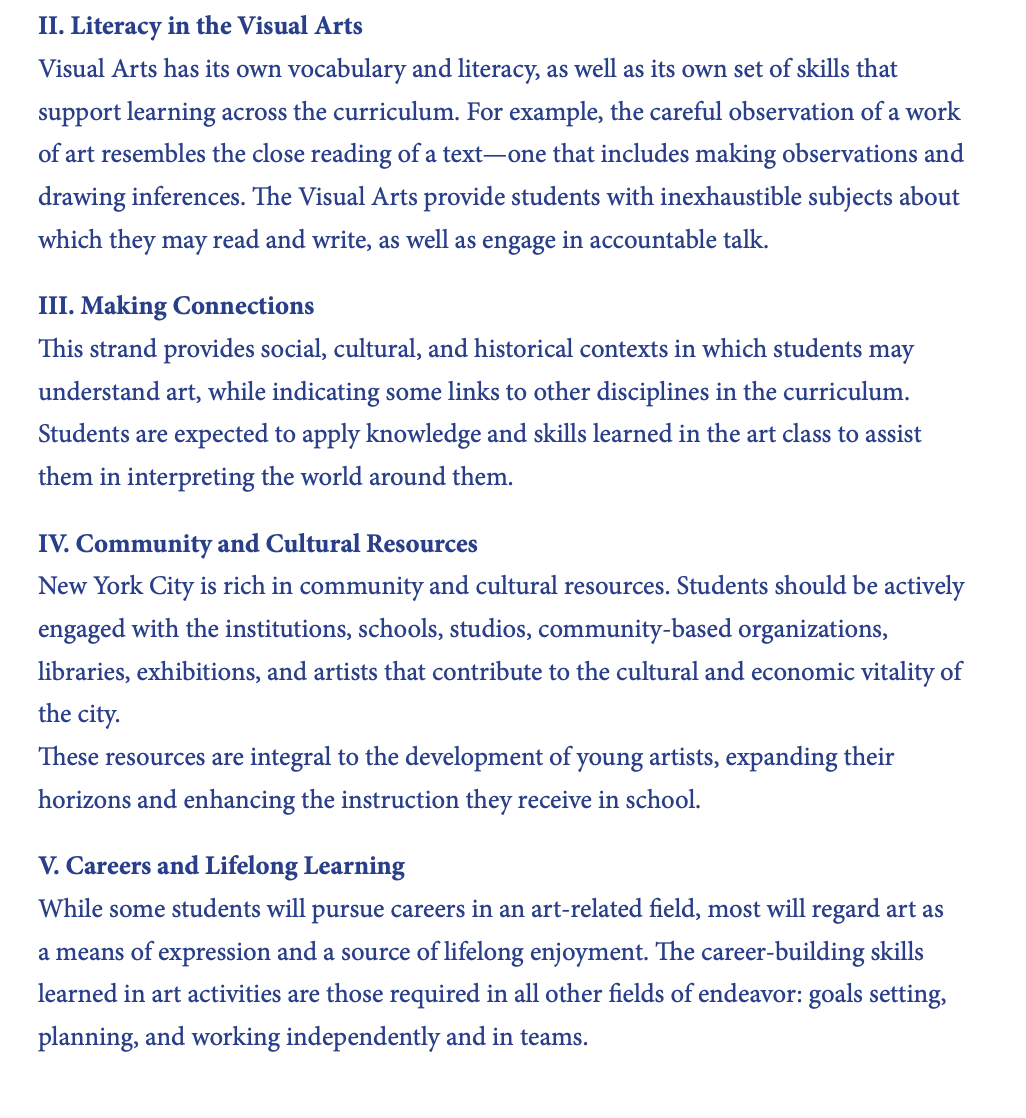Blueprint for Teaching and Learning in Visual Arts.Children living in New York City grow up within an artistic climate of extraordinary richness. "diversity of art forms, cultures, settings, and practices that entice visitors from around the world are available every day to our city’s youth. Yet, for this rich world to become part of the larger context of education, in-school learning must address youngsters’ own meaning making abilities and help them to become sensitive to those of others. Artistic development depends upon a facilitating environment organized to provide challenges and supports appropriate to youngsters’ abilities. Teachers should be mindful that not all children will be at the same developmental level. Five major strands appear in this document: Art Making, Literacy in the Visual Arts, Making Connections, Community and Cultural Resources, and Careers and Lifelong Learning. " Early Childhood and the Grade 2 Benchmark: Young children are active and exuberant explorers. Artistic images capture the physical and sensory aspects of their discoveries. Art making becomes an important spur to the use of imagination. Elementary Students and the Grade 5 Benchmark: Children become increasingly curious and are learning to become good observers of their everyday worlds. Making art stimulates thoughtful inquiry and sharpens careful perception. Children are interested in capturing the details that make each living thing, event or place unique in itself and special to them personally. " Middle School Students and the Grade 8 Benchmark: By adolescence, youngsters have developed powerful new thoughts and feelings that challenge established world-views. Painting, drawing, collage, printmaking, and art appreciation become important vehicles for testing ideas, making judgments, forming values and exercising curiosity. High School Students and the Grade 12 Benchmark: Some young people are pursuing art as part of their general education. For these youngsters continuing experiences with materials, combining observation and imagination and honing expressive skills, Further investigations in art, as outlined in the four other strands, provide opportunities for students to: become literate in art. make social, cultural, and historical connections. engage in learning beyond the classroom. share in the rich diversity of their communities. become lifelong learners and advocates for art. -What constitutes a child with special needs in the art classroom? Any student with physical, cognitive, or behavioral issues (or any combination) that interfere with or prevent independent functioning within a classroom setting is a student with special needs. -less proficient the student is in English, the more essential it is that the teacher provides visual cues and employs strategies such as demonstration and modeling. Planning and assessment are integral to creative teaching practice and a successful studio arts program. In designing an effective curriculum, teachers make countless decisions about the goals and content of lessons, materials and resources, the use of instructional time, as well as judgments about student progress. "teacher deliberately plans experiences that will nurture young artists. " experiences are connected from day to day, from unit to unit over the year. "ey intentionally sca$old skills, knowledge, and understanding critical to student achievement. A few overarching prompts can guide planning: Q Why is it important for students to learn about this? Q What should students know, understand, and be able to do? Q How will students demonstrate their learning? Q How will students assess their own learning? -An Overview of the Planning and Assessment Process Assessment of Prior Knowledge Determining what students already know, understand, and can do is essential for meaningful planning. Pre-assessment may include portfolio review of last year’s work, conversation with a previous teacher, a written questionnaire, a discussion with the class to determine ability to analyze and discuss work, knowledge of art vocabulary, or an initial art project to determine skill level and understanding. Assessment of Student Progress Identifying appropriate assessments is integral to the teacher’s planning process. Assessments make learning visible and demonstrate what students know, do, and understand as a result of instruction and provide a platform for successive levels of learning. " Two types of assessment: formative and summative. -Formative assessments may include questioning, teacher observation of student work, homework, quizzes, students’ responses to the teacher’s questions or classmates’ questions, journal/sketchbook entries, preliminary drawings, brief conferences, student self-re#ective writings, and rubrics. "ese kinds of assessments provide timely and useful feedback to the student. Summative -Assessment Summative assessments occurs the unit has been taught, and are used to document student achievement. Teachers use the information from these assessments to determine the overall effectiveness of the instructional Museum-based learning experiences are integral to units of study in the visual arts and address all strands. A museum trip may be self-guided or conducted by a museum educator. In each case, thoughtful preparation ensures seamless integration into the unit Museum One important goal of the visit is to encourage a lifelong interest in what museums provide. A successful museum experience ensures students understand that: the museum is an environment for the free exchange of ideas and opinions the museum has relevance to their lives. -arts are an important and explicit part of the school’s comprehensive instructional plan. * Great teachers know the power of the arts to transform, motivate, and inspire. Great arts teachers know the power of connecting their work to the teaching and learning in other subjects. Authentic connections reinforce the power and relevance of the arts, and add depth and dimension to studies in other disciplines. This post is one part of studying and reviewing after reading, Blueprint for Teaching and Learning in Visual Arts.
0 Comments
Leave a Reply. |
Myungja Anna KohArtist Categories
All
Archives
July 2024
|
Proudly powered by Weebly




 RSS Feed
RSS Feed